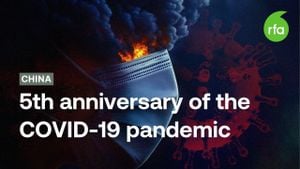Activists around the world are stepping up efforts to preserve and revitalize minority languages, tackling significant challenges stemming from societal changes and historical neglect. A notable example of this resurgence can be seen with Mayan languages, particularly through the work of activists like Nehemias Chablé Hau, who is using digital platforms to breathe life back to his native language, which faces declining use and recognition.
Chablé, 30, hailing from Tahdziu, Yucatan, is deeply committed to the preservation of the Mayan language, which he describes as central to his identity. "My language is a fundamental part of my identity, it is a link... I want to preserve and pass on to my sons, daughters and future generations," he shared with Global Voices, underscoring both the cultural and emotional ties to his heritage.
Through the 2024 Mayan Languages Digital Activism Fellowship, organized by Rising Voices, Chablé plans to implement projects aimed at younger generations. His initiatives include creating digital newsletters featuring the rich tales and legends of his community, encouraging children to participate actively in language preservation. By focusing on storytelling, Chablé hopes to instill confidence and pride within the community’s youth, fostering their connection to their linguistic roots.
Meanwhile, across the Atlantic, the Catalan language also faces its own set of challenges. Francesc Xavier Vila, the newly appointed Minister of Language Policy, has taken the reins at the forefront of these issues. Following years of political upheaval, which, according to Vila, pushed the language debate to the sidelines, there is now renewed focus on revitalizing Catalan usage.
Vila commented, "Real integration... must include learning Catalan," reflecting his administration's commitment to making the language more accessible to all citizens. He noted the importance of increasing the availability of Catalan courses, especially at the beginner levels, to cater to those struggling to connect with the heritage language.
The challenges are amplified by demographic shifts, particularly among younger people. Recent surveys reveal concerning trends: While the number of Catalan speakers is growing, the rate of growth is lagging behind the overall population increase. Vila emphasized this, lamenting the fact speculation influenced by contemporary digital culture, which saturates youngsters with exposure to Spanish through screens and social media.
Despite these setbacks, Vila is optimistic about the future. He mentioned efforts to create "safe learning spaces" to embolden learners to practice their language skills openly. Vila stated, "We need to substantially increase the availability of Catalan courses at all levels..." emphasizing the need for systemic changes aimed at normalizing the language usage across varied social settings.
Both Chablé and Vila's stories encapsulate the trials and triumphs faced by minority languages, highlighting the resilience of cultural identities amid modern predicaments. While they navigate these complex waters, their projects shine as beacons of hope—demonstrations of how technology and community involvement can breathe new life and vigor back to languages at risk of fading away.
Both activists recognize the power of the digital space as not only a tool for outreach but as a sanctuary for connection and expression. Chablé dreams of breaking the stigma surrounding the use of the Mayan language, hoping to empower children so they can assert the strength of their voice without fear. Vila, on the other hand, sees the need for collective engagement, attempting to bridge ideological divides to create community-led initiatives promoting language learning.
The fusion of technology and traditional storytelling may well be the key to restoring these endangered languages to their rightful places within their communities. By relying on digital mediums and fostering environments where cultural expressions can flourish, both the Mayan and Catalan languages stand poised for revitalization—renewing not only their presence but enriching the cultural fabric of their respective societies.



